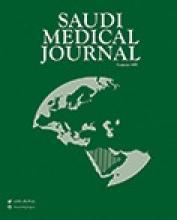To the Editor
We have read with interest the clinical image of pathological fracture by Alokaily.1 We would like to make a few comments. There are a number of features that make the diagnosis of Paget’s disease of bone (PDB) less likely: ethnicity and age of the patient, the modest elevation of the serum alkaline phosphatase (SAP), and the raised serum parathormone (PTH) level. However, the biopsy and the radiologic appearance are in favor. Paget’s disease of bone has rarely been reported in the Kingdom of Saudi Arabia2 and the Middle East,3 and is very rare under the age of 45 years.4 The reported patient with the pathological fracture is a Saudi native and is only 42-years-old. The modest elevation of SAP may be explained by the patient’s monostotic disease though the involvement is rather extensive. A radioisotope Technetium bone scan would have been useful in assessing the extent of the disease. A raised serum PTH has been reported in patients with PDB, but mainly in patients with low serum calcium.5 However, we postulate the raised serum PTH may be secondary to vitamin D deficiency. The biopsy reports thickened, slightly disorganized lamellar bone with osteoclastic resorption with partial replacement of the bone marrow by fibrovascular stroma. There is no mention of any anarchic bone formation to which many of the features of PDB are related. The replacement of the bone marrow by fibrous tissue is not a specific feature of PDB and may be related to osteoclastic rather than osteoblastic activity.6 It is unusual that a bone biopsy is needed to confirm the diagnosis of PDB, but it is necessary in a patient with monostotic disease and in whom the diagnosis is unlikely as in this case.
Reply from the Author
I have read your comments on the clinical image of the pathophysiological fracture secondary to Paget’s disease, with absolute agreement on every statement you mentioned. Paget’s disease as a cause of pathological fracture is a well-known clinical condition, however, as you have mentioned, in this part of the world (Saudi Arabia) it is extremely rare and this is the first time in my clinical practice I have seen a patient with such disease especially as the age was also against Paget’s disease, with the absence of involvement of other regions in the body. The patient was investigated thoroughly by an orthopedist when presented to rule out other causes of pathological fracture, investigations included radioisotope (Tc -99m bone scintigraphy), which showed an intense area of abnormal radiotracer involving the proximal portion of the left femur shaft with mild degree of bone displacement corresponding to subchondral fracture. The proximal portion of the left femur exhibited diffusely enhanced radiotracer uptake with evidence of bone expansion, which is also noted in the rest of the left femoral shaft with only mild degree of physiological radioactive distribution portrayed all over the rest of the scanned skeleton. The general impression was Paget’s disease involving the left femur with no evidence of the other lesions. Our concern was to rule out malignancy or other pathology since Paget’s disease was very unlikely clinically so the patient had bone biopsy while fixing the fracture and the histopathologists also considered the rarity of the case and described a bone with pagetoid changes that might be seen in hyperparathyroidism, and this should be correlated clinically. Our patient’s PTH level was not supportive of hyperparathyroidism with no underlying metabolic disease and no evidence of bone tumor. Due to the rarity of the case and unusual presentation, it is important to increase awareness of doctors in this region to the occurrence of such disease, and that it should be considered in patients with similar presentation.
Fahdah Alokaily
Division of Rheumatology, Department of Internal Medicine, Prince Sultan Military Medical City, Riyadh, Kingdom of Saudi Arabia
- Copyright: © Saudi Medical Journal
This is an open-access article distributed under the terms of the Creative Commons Attribution-Noncommercial-Share Alike 3.0 Unported, which permits unrestricted use, distribution, and reproduction in any medium, provided the original work is properly cited.






